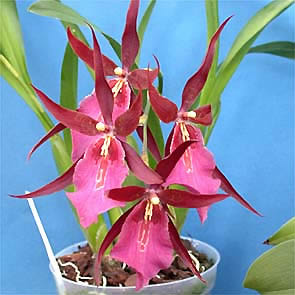Miltonia Orchid Care
Contents
The Miltonia orchids are epiphytes native to the South American continent where they grown from central Brazil down to Argentina. Miltonia orchids are priced for the delicate and highly appealing scent of their flowers. The pseudobulbs of these orchids produce one or two leaves which are covered in foliaceous sheath. The labellum (flower lip) is big and flat, and without any base callus. The column has two hard pollinia (waxy pollen clumps) and is without any foot.

Miltonia orchid
There are two different forms of orchid growth: sympodial and monopodial. The Miltonia species are sympodial which means that each new growth will arise from the rhizome of a previous growth, and each new growth is entirely capable of bearing an inflorescence (the flowering part of the orchid).
Potting medium
Miltonia orchids are epiphytic, which means that they live on trees. Planting them in ordinary soil is therefore a bad idea. If you don’t have a suitable tree for your Miltonia to grow on (after all, must of don’t have trees indoors) you can use a general bark or orchid mix as potting medium. The most important thing about the potting medium is it draining capacity.
Repotting a Miltonia orchid
Miltonia orchids need to be repotted at least once every second year. If the potting medium starts to smell bad, loose its draining capacity, or becomes infested with mould, you have to repot the orchid immediately. Such problems are often due to over watering.
Temperature
Miltonia orchids prefer environments where the nights are considerably cooler than the days. The recommended day temperature is 75-80°F (24-26.5°C), while the ideal night temperature is 60-65°F (15.5-18°C). A well established Miltonia orchid will usually survive occasional accidents, but prolonged exposure to unsuitable temperatures will be highly detrimental for these orchids.
Light
The Miltonia orchid prefers bright, but diffused, light. Direct sunlight is not recommended. Too little light will on the other hand prevent the Miltonia orchid from blossoming.
Watering
Unlike many other orchids, the Miltonia orchid does not prefer to have its potting medium completely dried out between waterings – the medium should instead be kept evenly moist if your want to give your plant the best possible Miltonia orchid care. Water the orchid during early morning to give the foliage a chance to dry before sunset. Miltonia orchids have no resting period when they don’t need any water; they want to be watered 12 months a year. Generally speaking, watering twice a week during the summer and once a week during the winter is enough.
Nutrients
The Miltonia orchid appreciates fertilizers year round. A high-nitrogen fertilizer (25-9-9) is recommended. 1 teaspoon of fertilizer per month is enough. Ideally separate the dose into several portions and drench the medium with ordinary water between each feeding.
Miltonia orchid trivia!
The Miltonia orchids are name after Charles Wentworth-FitzWilliam, 5th Earl FitzWilliam, Viscount Milton. Milton was the President of the Royal Statistical Society in England and an avid orchid enthusiast.
In Other Languages: Miltonia på Svenska